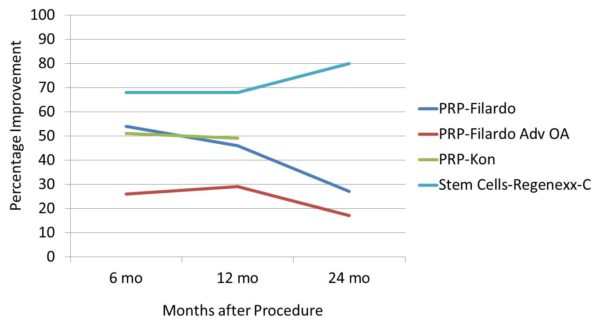PRP vs. Stem Cells for Knee Arthritis-What does the Data Say?

©Regenexx
PRP vs. stem cells for knee arthritis? First, let me say we love platelet rich plasma and have used platelet mixtures for many years. At the same time, we’ve been under-impressed with the ability of PRP to treat knee arthritis. First, PRP means platelet rich plasma, which is a concentration of the patient’s blood platelets. The goal of PRP is to concentrate the growth factors in platelets that help tissue heal. In order to compare the effectiveness of PRP compared to stem cells to treat knee arthritis over two years, I reviewed three PRP studies published in the past 12 months for the treatment of knee arthritis. One of these is a very small study of 14 patients, so it was excluded, as the Regenexx-C data is on more than 200 patients. The other two studies had about 100 patients each and reported things like severity of the arthritis, so they were included. One concern for any injection based treatment in the knee is that more severe arthritis may not respond as well as more mild knee arthritis. One study only looked at patients for 12 months (Kon) and the other study followed patients for 24 months (Filardo). However, these two PRP studies for knee arthritis included patients with much less severe arthritis than those treated in our Regenexx-C procedure study. For example, note below that the Filardo PRP study only has a very small percentage of patients who were knee replacement candidates (about 1/4), while the Regenexx-C study had more than 2/3’rds of the patients with more severe knee arthritis who needed a knee replacement (listed as “TKA Candidate”).
To create a head to head comparison graph of the knee PRP data and the Regenexx stem cell outcome data, a little math was needed. Since all studies used slighly different patient outcome questionnaires, each was normalized for percentage improvement. For example, if one knee disability scale used in one study went from 40 points to 20 points (where a lower score means better knee function), this was converted to a 50% improvement. Looking above, you can see the two PRP studies (Kon and Filardo) graphed as percentage improvement. In both, at 6 months, the patients are reporting about a mean 50% improvement in their knee symptoms. However, this includes all patients, the vast majority of which had only mild arthritis. If we take out the group from the Filardo PRP knee study with more severe knee arthritis (listed as the red line or “PRP-Filardo Adv OA”), the results are much less robust. These patients end up with a bit more than 25% relief at 6 months, peak out at a bit less than 30% at 12 months, and then fall off to less than 20% relief at 24 months. In fact, even including the milder knee arthritis group, the Filardo study reported a mean duration of relief of only about 9 months. This shorter duration of relief is very similar to how mild knee arthritis patients respond to SynVisc injections (other name brands are Supartz, OrthoVisc, Euflexa, Hyalgan, etc…). Now note the Regenexx-C stem cell injections above (listed as “Stem Cells-Regenexx-C”). The relief starts out at 6 and 12 months at just under 70% and then improves from 12 to 24 months to about 80%. This data is more consistent with what’s seen in cartilage healing studies where micro fracture or knee ACI surgeries are performed, except that these Regenexx-C patients only received injections. The upshot? While trying to compare data from different studies is always difficult, however this comparison appears to follow what we see in the clinic-for knee arthritis, stem cells beat PRP.

NOTE: This blog post provides general information to help the reader better understand regenerative medicine, musculoskeletal health, and related subjects. All content provided in this blog, website, or any linked materials, including text, graphics, images, patient profiles, outcomes, and information, are not intended and should not be considered or used as a substitute for medical advice, diagnosis, or treatment. Please always consult with a professional and certified healthcare provider to discuss if a treatment is right for you.

